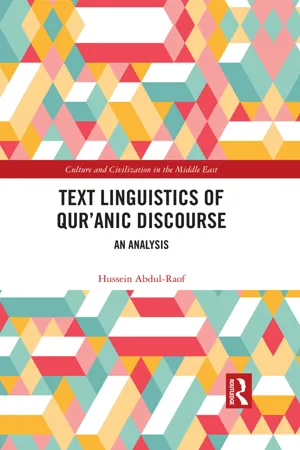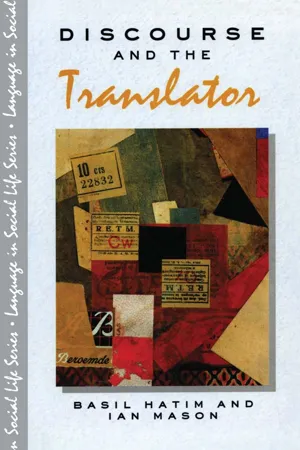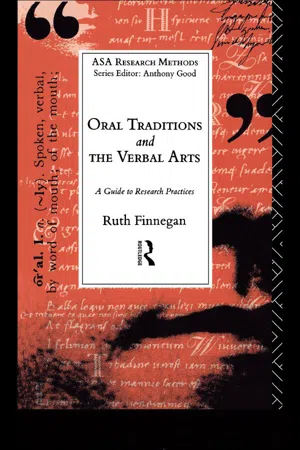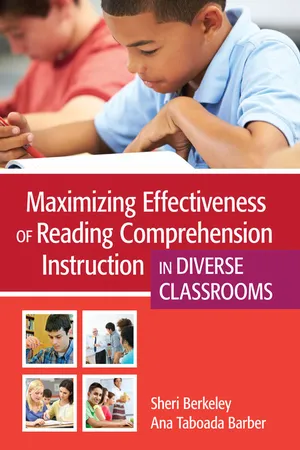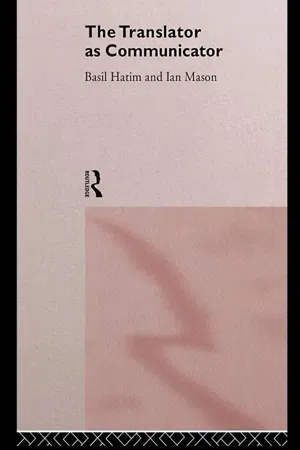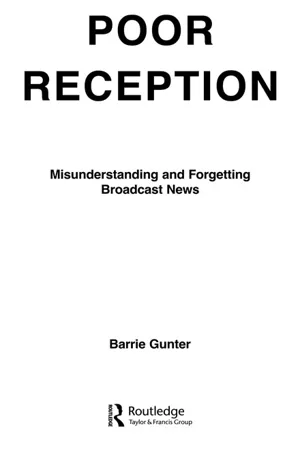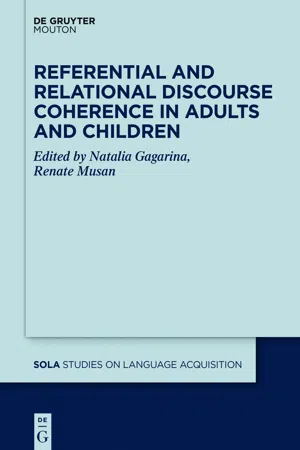Languages & Linguistics
Text Structure
Text structure refers to the way written material is organized. It encompasses the arrangement of ideas, details, and information within a text. Common text structures include chronological order, cause and effect, compare and contrast, problem and solution, and description. Understanding text structure helps readers comprehend and analyze written works more effectively.
Written by Perlego with AI-assistance
Related key terms
Related key terms
1 of 4
Related key terms
1 of 3
10 Key excerpts on "Text Structure"
- eBook - ePub
Text Linguistics of Qur'anic Discourse
An Analysis
- Hussein Abdul-Raof(Author)
- 2018(Publication Date)
- Routledge(Publisher)
Text linguistics emerged during the 1970s as a new discipline but has remained a branch of mainstream linguistics. It is concerned with the description and analysis of macro spoken and written texts. In other words, the text is the major and largest linguistic sign/unit which is worthy of analysis rather than its constituent single words, phrases, or sentences. Text linguistics studies the communicative relationship through texts between the text producer (writer/speaker) and the text receiver (reader/hearer). It studies the communicative employment of cohesive devices in the construction of a given text. Text linguistics is concerned with the flow of information intra-sententially (within the same sentence) and inter-sententially (among different sentences) by looking at text linguistic features of the text like coherence, cohesion, the organization of old/given/known (unmarked) information and new/unknown (marked) information which are constituents of the Text Structure. In text linguistics, we focus on the linguistic processes of text cohesion and text coherence.In text linguistics, the text is a communication system and has a communication function. In the view of Dirven and Vespoor (2004:180), text linguistics is concerned with the study of how a writer/speaker and a reader/hearer manage to communicate through texts. In other words, how the text producer and the text receiver can go beyond the text, i.e., how they effectively employ cohesive devices (adawāt al-rabṭ), such as (wa – and), (bisabab – because), (thumma – then), and (walākin – but), in order to construct sentential and paragraph relations within a given text.Text linguistics is different from traditional structural linguistics. The latter focuses on sentence grammar, i.e., sentence structure, and is concerned primarily with the sentence as the largest linguistic unit in linguistic analysis. However, text linguistics views the sentence as a micro unit of language and is concerned with the Text Structure and textuality. Linguistic analysis should be carried out at the macro level, the text, and the sentence is only a part of the macro text.For more details, see Dressler (1978:21); Trask (1997:219); Beaugrande and Dressler (1981:ii, 3); Crystal (2003:234–235, 462); and Hatim and Munday (2004:350).1.3 Major notions in text linguisticsThe major notions in text linguistics include: text, subtext, context of situation, texture, cohesive ties, standards of textuality, and macro functions of text (field, tenor, and mode), and text types. These are discussed in what follows.1.3.1 Text
The word ‘text’ is derived from the Latin verb (texere) meaning to weave, to compose, or to contrive. In other words, the words are woven together in a text. A text enjoys inherent lexicogrammatical and stylistic hallmarks which reflect the social and cultural context in which a specific text occurs. A text should constitute a congruent discourse (kalām mutalā’im). A text should be well formed (faṣīḥ) and be free from rhetorical deficiency (c uyūb balāghiyyah) and sluggish sentences (jumal mutanāfirah). A text should also enjoy continuity and progression. On the lexical, grammatical, and stylistic levels, the text is influenced by its social event. Thus, the context of situation is the womb of the text. On the stylistic level, the text should avoid distasteful style and unnaturalness (c - eBook - ePub
- B. Hatim, Ian Mason(Authors)
- 2014(Publication Date)
- Routledge(Publisher)
These contextual factors are probably universal features of language use; ways of realising them, however, may not be. Cultural context is, then, an important factor in determining structural arrangement so that, for the translator, the important question will be: what is the status of any given structure in the actual process of translating. Where two languages do not share a structural pattern, what is the translator's room for manoeuvre in making modifications?To answer questions such as these, we have firstly to consider the relationship between context and structure. In this book, following Hasan (e.g. 1985), we submit that use of any given structure is motivated by the way text users react to context. More specifically, users pursue a rhetorical purpose which becomes the focus of a particular text type. As we argued in Chapter 8 , this focus reflects the way a given culture organises textual material in terms of signs. We recognise these signs within familiar generic, discoursal and textual structures. The underlying principle of this whole process is intertextuality, our ability to recognise and produce texts as tokens of a type.Another factor involved in our choice of particular structures is intentionality. Together, the signs and the intentions behind their use ensure successful communication. For example, in courtroom interaction, the intention ‘to raise an objection’ is effectively relayed only when it is recognised as a sign. Activities such as ‘objecting’ display their own structural formats, and structure becomes an important indicator of what is going on in interaction.CONTEXTUAL CONFIGURATION
How do the various contextual variables find expression in structure and, ultimately, in texture? As we suggested in Chapter 8 , ‘register’ provides an ideal link between context and Text Structure. Hasan (e.g. 1977) introduces the term contextual configuration to refer to those values from the whole range of field, tenor or mode, actually selected in any particular instance of communication (text) within a particular discourse or genre. Thus, it is important to realise that the contextual configuration is a concrete representation, relevant only to one specific instance within a particular genre. By way of illustration, Hasan (1977:234) provides a characterisation of a text which begins with ‘Good morning > Dr Scott's clinic > May I help you?’. This is reproduced in Fig. 9.4 - eBook - ePub
Language, Literature and Critical Practice
Ways of Analysing Text
- David Birch(Author)
- 2005(Publication Date)
- Routledge(Publisher)
29 The structuralist linguistic approach to the analysis of text can be summarized as follows: 1 There is emphasis on the need to be formally explicit and rigorous in the analysis of linguistic structures.2 This explicitness is designed to enable the analysis of texts to exemplify the idealized world of linguistic systems rather than the actual world of real discourses, though with critical linguistics this situation is changing.3 There are two main approaches to structuralist linguistic analysis of text: the psychological and the sociological. Both are concerned with understanding the system of language, but the sociological is more concerned with situationally determined meanings than is the psychological.4 The concentration on understanding linguistic systems involves a greater emphasis on universals and codes of language. This type of analysis of literary text is therefore much more about isolating universal linguistic structures, codes, and myths than it is with textual interpretations, explanations of readings, and discussions of intuitions about texts. This is the theoretical base of the structuralist linguistic enterprise, though in practice many literary-based linguists more interested in discourse analysis and textual explication than in developing theoretical arguments and philosophies concentrate on a linguistics that is effectively a language-aware practical criticism. It is therefore important to distinguish between the linguistics-theorists who conduct text analysis for systemic reasons and the applied linguists/critics who conduct text analysis for purposes of evaluation and interpretation. - eBook - ePub
Oral Traditions and the Verbal Arts
A Guide to Research Practices
- Ruth Finnegan(Author)
- 2003(Publication Date)
- Routledge(Publisher)
Analysing a text’s internal organisation raises a series of questions to investigate. These include: the ordering and development of the text (paratactic, sequential, ‘envelope patterns’/‘ring structure’ (see Foley 1987a:245ff, Lord 1986a:53ff) and so on); sub-divisions within the text and how these are achieved (as by songs or dialogues within stories, moves of scene or time, or differing linguistic registers); formulaic runs and patternings; opening and closing formulae; and recurrent patterns for starting and coming to an end. Larger questions arise too: is the basic structure ‘prose’ or ‘verse’ and in what sense; if there are ‘lines’, ‘verses’, or ‘stanzas’ how are these defined and what is their relation to each other; what are the principles of punctuation, syntax or subdivision with which oral versions have been organised into written transcriptions; how do performance practices (separated in time perhaps) affect questions of artistic unity and the structure of the text; what is the structural interplay within texts between differing modes of performance? There are also questions about the logical and persuasive structure underlying the argument (see Perelman and Olbrechts-Tyteca 1969). All in all such analyses often reveal more systematic, recurrent and artful patterns than appear on the surface.Such questions sometimes feed into narratological or other distinctive approaches, but can also be pursued almost whatever your theoretical orientation. Their investigation may anyway be needed for the practical reason that they affect how you present your transcriptions as texts. For example where should paragraph, line or stanza divisions come? Where does a ‘separate’ story or song begin and end? What do the apparent textual unity or sub-divisions conveyed on the printed page represent in the original performance (see also 9.3 - Sheri Berkeley, Ana Taboada Barber(Authors)
- 2015(Publication Date)
- Brookes Publishing(Publisher)
Narrative text: Novels, short stories, folktales, tall tales, myths, fables, legends, fantasiesExpository text: Textbooks, biographies, newspapers/magazines, how-to texts (e.g., recipes, manuals, brochures)Typical structureNarrative text: Story grammar (character, setting, conflict, resolution)Expository text: Temporal (time or order sequences), descriptive (or definition/example), collection (listing), compare and contrast, cause and effect (or problem and solution)Text featuresNarrative text: Title, chapters, illustrations (in picture books)Expository text: Table of contents; preface; chapter introductions; chapter headings and subheadings; marginal notes; chapter summaries; maps, charts, graphs, and illustrations; index; glossaryCharacteristicsNarrative text: Written in language that is similar to spoken language in style; familiar ideas with themes that often connect to reader’s experiencesExpository text: Formal language with large numbers of vocabulary terms that may be unfamiliar to the reader; highly technical, multisyllabic words; structural complexity and variety and information density; reader often may not have background knowledge; varies in writing style (persuasion, how to, informative)As with all reading strategies, understanding Text Structure is a tool for students to use to help them comprehend, not an end goal in and of itself (Calkins, 2001; Institute of Education Sciences, 2010). “Text Structure instruction makes the invisible visible so readers can use the content and the structure of the text itself as a tool to enhance understanding, to manipulate their thinking, and revise their existing knowledge, beliefs, and feelings” (Keene, 2008, p. 179). This process of making the Text Structure overt helps students extract and construct meaning while reading (Jitendra & Gajria, 2011). Furthermore, students are more likely to use other appropriate strategies to help gain meaning from text (e.g., activating prior knowledge, previewing the text, setting a purpose for reading) when they recognize the structure of the text (Denton et al., 2012).- eBook - ePub
- Basil Hatim, Ian Mason(Authors)
- 2005(Publication Date)
- Routledge(Publisher)
In the preceding sections, we have argued for the need to view texts in terms of a model of textuality within which we recognize three basic strands of textual activity: the contextual specification of texts, their structure and their texture. But these aspects of textuality cannot be equally prominent in all situations of text use. In interpreting, for example, as the nature of the task varies, text utilization strategies seem to vary and different ones are resorted to. Take for instance the case of consecutive interpreting. Here, given ideal conditions of performance, interpreters cannot hope to avail themselves of what a text offers by way of cohesion, theme-rheme progression and so on. In these circumstances, Text Structure must be paramount in a skill that involves rendering in a reduced form a text delivered at natural speed, often in a style that is less than fully coherent.Incidentally, this kind of casual style of delivery raises an important issue that has been used by critics of applied text linguistics. In the context of interpreter training, the argument would no doubt be that, if very few speakers structure their texts as the discourse analyst would have them do, what is the point of telling the consecutive interpreter about Text Structure? Or, if very few politicians stick to the point or speak in context, what is the point of telling the liaison interpreter about the role of context in the development of texts? Or, if very few international delegates produce texts that are at all times both cohesive and coherent, what is the point of telling the simultaneous interpreter to heed texture in his or her attempts to listen and deliver intelligibly?To this, we can only say that such impressions of what goes on after dinners, in interviews or in international conferences are all true regarding what happens in real life most of the time. But it is this very fact that makes it that much more worthwhile to tell interpreters about this or that strand of textuality and about how it relates both to text and to a given interpreting task. The fact that texture could be lacking, for example, can only support the argument that learning to operate with an idealized norm is a sure way of spotting and dealing with deviations. Being trained to respond to the various manifestations of texture, structure or context is thus a crucial part of guaranteeing that the interpreter is on the alert.Interpreter-training institutions the world over tend to combine training in different forms of interpreting. The philosophy behind such an approach seems to be that interpreters must be prepared to handle whatever is thrown at them. However, as we have just seen, the various standards of textuality are not implicated to the same extent in all forms of interpreting. Thus, through some form of needs analysis, in the light of trainee interests or staff competence or simply as a convenient pedagogic device, we ought to be able to narrow the set of options and identify certain useful trends. A well-thought-out programme should reveal that in a given situation, this interpreting skill is more in demand than others. In cases like these, it is essential that specialized training modules be developed to focus our efforts on the discourse mechanics of a particular skill. - eBook - ePub
Poor Reception
Misunderstanding and Forgetting Broadcast News
- Barrie Gunter(Author)
- 2012(Publication Date)
- Routledge(Publisher)
global structures; the former refer to sentences or particular connections between sentences, while the latter refer to paragraph structrures or even the entire discourse.It is possible to carry out analysis of discourse at these various levels, focusing on the local dimensions, such as the meanings or physical structures of words and sentences, or more globally looking at the themes conveyed by the discourse as a whole. Any mode of analysis that directly concerns the contents of the discourse is called textual Some researchers have pointed out in addition, however, that discourses are not simply isolated linguistic entities but exist in a socio-cultural framework that is also important to the way the discourse is interpreted and understood. A narrative may therefore be analysed also in terms of the latter contextual properties.DISCOURSE ANALYSIS AND MASS COMMUNICATION RESEARCH
Sociological studies of newsrooms have indicated that news is not simply a description of events but is a specific kind of reconstruction of reality. This reconstruction is determined by professional practices concerned with ways of how best to present news and in line with the norms and values of the society in which the news is made. News production has been revealed as a complex set of processes and professional routines that govern the selection and appropriate formulation of news stories for presentation to mass audiences. News production is not a direct representation of events, however, no matter what many journalists might claim and irrespective of the supposed intentions of “eyewitness” news formats. Often reporters are not direct witnesses to events; instead their accounts are derived from discourses from other sources, such as eyewitness reports, press conferences, official statements, interviews, or news input from other media or press agencies. Hence, the construction of the news as we see or hear it is frequently a reconstruction of available discourses. The way news editors and reporters place their own interpretations on these discourses has an important bearing on the way the news is structured and presented, which in turn may have significant consequences for the comprehensibility of the final news product received by the audience. - eBook - ePub
- Kirsten Malmkjaer, Kirsten Malmkjaer(Authors)
- 2009(Publication Date)
- Routledge(Publisher)
TText linguistics
Background
As Hoey points out (1983–4: 1),The distinction Hoey mentions is made in this volume on practical, not theoretical grounds, and the overlap between text linguistics and discourse and conversation analysis should be borne in mind.there is a tendency … to make a hard-and- fast distinction between discourse (spoken) and text (written). This is reflec-ted even in two of the names of the discipline( s) we study, discourse analysis and text linguistics. But, though the distinction is a necessary one to maintain for some purposes … it may at times obscure similarities in the organisation of the spoken and written word.Early modern linguistics, with its emphasis on discovering and describing the minimal units of each of the linguistic levels of sound, form, syntax and semantics, made no provision for the study of long stretches of text as such; traditional grammatical analysis stops at sentence length. It is even possible to argue that ‘the extraction of tiny components diverts consideration away from the important unities which bind a text together’ (de Beaugrande and Dressler 1981: 21) and, although Zellig Harris (1952) had proposed to analyse whole discourses on distributional principles, employing the notion of transformations between stretches of text, this emergent interest in text and discourse study was lost at the time in Chomsky’s modification of the notion of transformation to an intrasentential phenomenon. - eBook - ePub
- Teun A. van Dijk(Author)
- 2013(Publication Date)
- Routledge(Publisher)
McLaughlin. 1984 ).Text Linguistics
Among the many other branches of discourse analysis that emerged in the 1960s was a more linguistic approach to mostly written texts, a development taking place mainly in continental Europe, primarily in East and West Germany and surrounding countries. Methodologically, this so-called text linguistics, and especially its more specific direction called text grammar, first sought its inspiration in generative transformational grammars, as developed by Chomsky. Much like most other discourse analysts in other disciplines, they rejected the artificial boundary of the sentence and argued that linguistic competence and its rules should also extend to textual structures beyond the sentence (Petöfi, 1971; van Dijk, 1972, 1977; Dressier, 1972; Petöfi & Rieser, 1973; de Beaugrande & Dressier, 1981). It was argued that many properties of syntax, and expecially those of semantics, were not limited to one sentence but rather characterize sequences of clauses, sentences, or whole texts; pronouns; definite and indefinite articles; demonstratives; many adverbs; connectives of various types; and phenomena such as presupposition, coherence, and topicality. From a somewhat different perspective, similar points were made by other linguists (Halliday & Hasan, 1976; Longacre, 1977). In more strictly syntactic and semantic sentence grammars, it was soon realized that many properties of sentence form and meaning require at least a discourse perspective (Givón, 1979). And although many directions of current linguistics and grammars are still focusing on sentence structures, it becomes more and more accepted that a systematic description of language, whether in abstract grammatical terms, or in terms of theories of language use, should also incorporate discourse forms. It should be added, however, that text grammar, other directions of text linguistics, or any other linguistic approach to discourse have merged with other branches of discourse analysis in recent years. There may be differences in historical developments and influences or interest for different discourse types and phenomena, but all have at least one common central aim—to elaborate an explicit theory of the various structures of spoken or written discourse (see de Beaugrande, 1980 ; Tannen, 1982 ; van Dijk, 1985a - Natalia Gagarina, Renate Musan, Natalia Gagarina, Renate Musan(Authors)
- 2020(Publication Date)
- De Gruyter Mouton(Publisher)
1998; Barton 2007; Janks 2010). The organization of texts has a long history of investigation, which started from the seminal study by Berman and Slobin (1994) on the elicited Frog Stories (Mayer 1969, Frog, where are you?), in which they applied Stein and Glenn’s (1979) story grammar to trace the developmental trajectory of the macrostructural organization of oral narratives. While monolingual (narrative) text organization has been investigated representatively as far as age, languages and populations are concerned (Berman and Slobin 1994; Hickmann 2004; Peterson and McCabe 1993), bilingual narrative texts have been examined far less extensively. This is surprising because skills organizing texts are especially interesting in bilinguals, who might know how to organize a text on a macrostructural level, while they might be at a disadvantage with regards to their lexical or grammatical knowledge. The episodic organization of a text at the level of macrostructure, i.e. the event structure and the components of story grammar, is considered to be more language (proficiency)-independent. Microstructure, on the other hand, is expressed by language-specific elements used for the construction of coherent discourse, such as noun and verb phrases, prepositions and connectives (cf. Iluz-Cohen and Walters 2012; Pearson 2002). Narrative texts as a data source can provide information on both the general cognitive abilities of a story-teller having to deal with the episodic structure, and his/her language-specific skills. They tap into various levels of language and cognition and can be used for the investigation of typically developing children and children with developmental language disorder (DLD)
Index pages curate the most relevant extracts from our library of academic textbooks. They’ve been created using an in-house natural language model (NLM), each adding context and meaning to key research topics.
Explore more topic indexes
Explore more topic indexes
1 of 6
Explore more topic indexes
1 of 4
